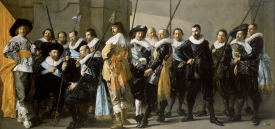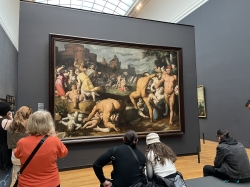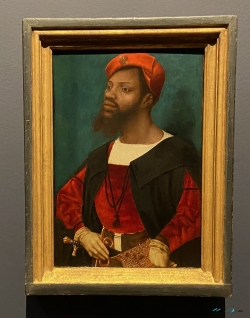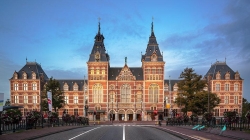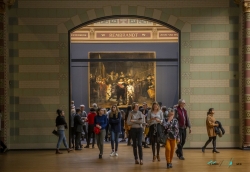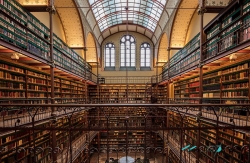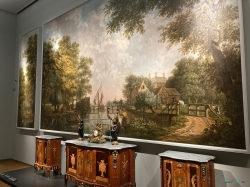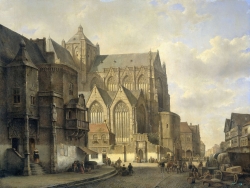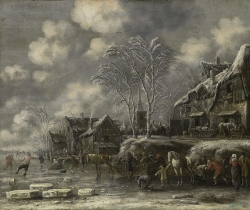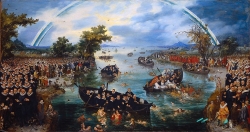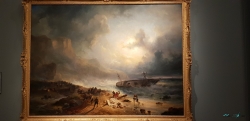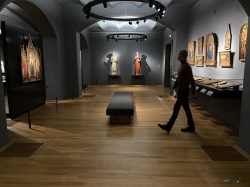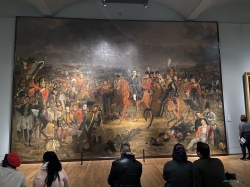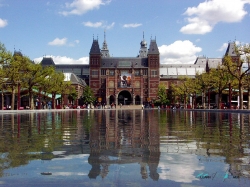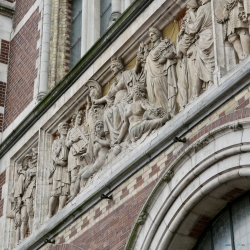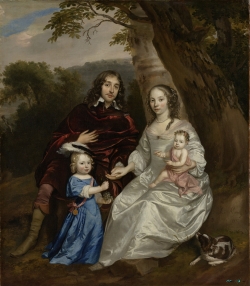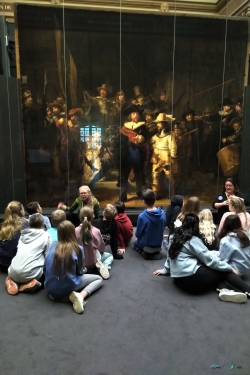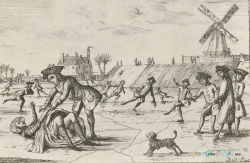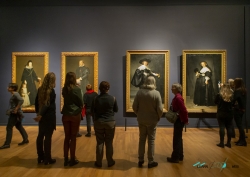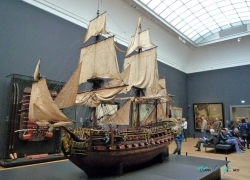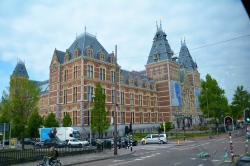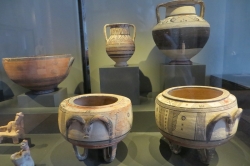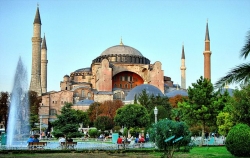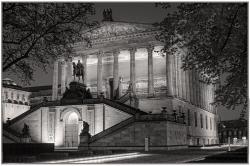ABOUT Rijksmuseum
The Rijksmuseum in Amsterdam is one of sixteen national museums in the Netherlands. The collection offers an overview of Dutch art and history, including works by 17th-century Dutch masters such as Rembrandt, Vermeer and Hals. The museum has been housed in the Rijksmuseum building since 1885, which was designed by the Dutch architect Pierre Cuypers.
The art collection that the stadholder's family had built up over the centuries forms the basis of the Rijksmuseum's collection. After the last stadtholder fled the country in 1795, the Batavian Republic confiscated the remaining art collection. Most of this was shipped to Paris by the French. On November 19, 1798, at the initiative of the agent of finance, Alexander Gogel, it was decided to house the remaining collection, consisting of Italian art, portraits of the Oranges and national rarities, in a national museum after the French example. Under the name Nationale Konst-Gallery, this museum opened its doors on May 31, 1800 in the also confiscated Huis ten Bosch near The Hague. The Amsterdam art dealer Cornelis Sebille Roos (1754-1820) was the first director of the museum and as such, in collaboration with Gogel, was responsible for the first acquisitions, including The endangered swan by Jan Asselijn. When in 1806 Lodewijk Napoleon ascended the throne of the 'Kingdom of Holland', it was given the name Royal Museum.
In 1808 the museum was moved to Amsterdam by order of Lodewijk Napoleon, where from 1809 it was housed together with the art collection of Amsterdam – including De Nachtwacht – on the top floor of the Palace on Dam Square. The new director, Cornelis Apostool, was charged with compiling a catalog of objects. In 1817 the collection of the Rijks Museum, as it was now known after the accession of William I, moved to the 17th-century Trippenhuis. After the fall of Napoleon in 1815, an important part of the works of art that had been transferred to Paris by the French from 1795 and reclaimed by the Netherlands also ended up here.
The acquisition of the collection, which the Amsterdam banker Adriaan van der Hoop bequeathed to the municipality of Amsterdam in 1854, was therefore by no means a matter of course. The importance of the 224 paintings for attracting foreigners to the city was not believed. The board imposed the condition that ƒ 40,000 of the ƒ 50,000 for inheritance tax should be raised through voluntary private contributions. Had a few wealthy citizens not wanted to keep the 224 paintings for the country, the masterpieces would have disappeared abroad.
In 1885, the current Rijksmuseum building was built after a design by P.J.H. Cuypers completed. This building not only housed the collection of the Rijksmuseum, but also the collection of works by living masters, which was housed in the Museum of Living Dutch Masters in Haarlem from 1838, and the Nederlandsch Museum for History and Art in The Hague were housed in the accommodated new building.
On the eve of the Second World War, part of the collection was taken to safety elsewhere. Exhibitions with contemporary art were held in the vacant space, such as the exhibition Our art of today in 1939-1940. In April 1942, a large part of the Rijksmuseum's collection was stored in a purpose-built vault in the underground passages of Sint-Pietersberg near Maastricht. During the war period, the Rijksmuseum held various German-friendly exhibitions such as Westphalian-Nederrijnsche Kunst van Heden (August 1941), Frauenschaffen in Deutschland, Deutsche Frauen arbeiten für ihr Volk (October 1941), Das Deutsche Buch der Gegenwart (February 1942) and Kunst der Front (January 1943).
In 1995 the museum was made independent. It used to be a Rijksmuseum with civil servants, from 1995 the museum has been run by the Rijksmuseum foundation, with the building and part of the collection in the hands of the State.
The art collection that the stadholder's family had built up over the centuries forms the basis of the Rijksmuseum's collection. After the last stadtholder fled the country in 1795, the Batavian Republic confiscated the remaining art collection. Most of this was shipped to Paris by the French. On November 19, 1798, at the initiative of the agent of finance, Alexander Gogel, it was decided to house the remaining collection, consisting of Italian art, portraits of the Oranges and national rarities, in a national museum after the French example. Under the name Nationale Konst-Gallery, this museum opened its doors on May 31, 1800 in the also confiscated Huis ten Bosch near The Hague. The Amsterdam art dealer Cornelis Sebille Roos (1754-1820) was the first director of the museum and as such, in collaboration with Gogel, was responsible for the first acquisitions, including The endangered swan by Jan Asselijn. When in 1806 Lodewijk Napoleon ascended the throne of the 'Kingdom of Holland', it was given the name Royal Museum.
In 1808 the museum was moved to Amsterdam by order of Lodewijk Napoleon, where from 1809 it was housed together with the art collection of Amsterdam – including De Nachtwacht – on the top floor of the Palace on Dam Square. The new director, Cornelis Apostool, was charged with compiling a catalog of objects. In 1817 the collection of the Rijks Museum, as it was now known after the accession of William I, moved to the 17th-century Trippenhuis. After the fall of Napoleon in 1815, an important part of the works of art that had been transferred to Paris by the French from 1795 and reclaimed by the Netherlands also ended up here.
The acquisition of the collection, which the Amsterdam banker Adriaan van der Hoop bequeathed to the municipality of Amsterdam in 1854, was therefore by no means a matter of course. The importance of the 224 paintings for attracting foreigners to the city was not believed. The board imposed the condition that ƒ 40,000 of the ƒ 50,000 for inheritance tax should be raised through voluntary private contributions. Had a few wealthy citizens not wanted to keep the 224 paintings for the country, the masterpieces would have disappeared abroad.
In 1885, the current Rijksmuseum building was built after a design by P.J.H. Cuypers completed. This building not only housed the collection of the Rijksmuseum, but also the collection of works by living masters, which was housed in the Museum of Living Dutch Masters in Haarlem from 1838, and the Nederlandsch Museum for History and Art in The Hague were housed in the accommodated new building.
On the eve of the Second World War, part of the collection was taken to safety elsewhere. Exhibitions with contemporary art were held in the vacant space, such as the exhibition Our art of today in 1939-1940. In April 1942, a large part of the Rijksmuseum's collection was stored in a purpose-built vault in the underground passages of Sint-Pietersberg near Maastricht. During the war period, the Rijksmuseum held various German-friendly exhibitions such as Westphalian-Nederrijnsche Kunst van Heden (August 1941), Frauenschaffen in Deutschland, Deutsche Frauen arbeiten für ihr Volk (October 1941), Das Deutsche Buch der Gegenwart (February 1942) and Kunst der Front (January 1943).
In 1995 the museum was made independent. It used to be a Rijksmuseum with civil servants, from 1995 the museum has been run by the Rijksmuseum foundation, with the building and part of the collection in the hands of the State.
The Best Pictures of Rijksmuseum
Videos of Rijksmuseum










